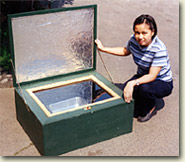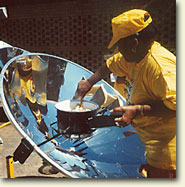Paul Hedrick (talk | contribs) |
Tom Sponheim (talk | contribs) |
||
| (6 intermediate revisions by 2 users not shown) | |||
| Line 2: | Line 2: | ||
{{Updated|9|30|14}} |
{{Updated|9|30|14}} |
||
| ⚫ | |||
| ⚫ | |||
| + | |||
| ⚫ | |||
| ⚫ | Sunlight is the "fuel." A solar cooker needs an outdoor spot that is sunny for several hours and protected from strong wind, and where food will be safe. Solar cookers don't work at night or on cloudy days, though during the best months for cooking, many foods can be cooked under intermittent clouds or a light haze, as long as food is put out early and there is definitely more sun than not overall. Extra covers or simple foiled boosters can help under marginal skies. |
||
| + | |||
| ⚫ | |||
| ⚫ | At its simplest, the sunlight-to-heat conversion occurs when photons (particles of light) moving around within light waves interact with molecules moving around in a substance. The rays emitted by the sun have a lot of energy in them. When they strike matter, whether solid or liquid, all of this energy causes the molecules in that matter to vibrate. They get excited and start jumping around. [[Principles_of_Solar_Box_Cooker_Design#Heat_gain|This activity generates heat]]. |
||
| + | |||
| ⚫ | |||
| + | {{Main|Pots}} |
||
| + | |||
| ⚫ | |||
| + | |||
| ⚫ | A transparent heat trap around the dark pot lets in the sunlight, and keeps the heat that is produced from escaping. This is a clear, heat-resistant plastic bag or large inverted glass bowl (in panel cookers) or an insulated box with a glass or plastic window (in box cookers). Curved concentrator cookers typically don't require a heat trap. |
||
| + | {{Main|Glazing}} |
||
| + | |||
| ⚫ | |||
| ⚫ | One or more shiny surfaces reflect extra sunlight onto the pot, increasing its heat potential. Mirrors, aluminum foil, mylar, mirror-finish metals, chrome sign vinyl, and other shiny materials have all been used successfully for solar cooking, depending on the type of cooker and the environment in which it will be used. |
||
| + | {{Main|Reflective material}} |
||
| + | |||
==Types== |
==Types== |
||
The three most common types of solar cookers are [[box cookers]], curved concentrators ([[Parabolic cookers|parabolics]]) and [[panel cookers]]. Hundreds — if not thousands — of variations on these basic types exist. Additionally, several large-scale solar cooking systems have been developed to meet the needs of institutions worldwide. |
The three most common types of solar cookers are [[box cookers]], curved concentrators ([[Parabolic cookers|parabolics]]) and [[panel cookers]]. Hundreds — if not thousands — of variations on these basic types exist. Additionally, several large-scale solar cooking systems have been developed to meet the needs of institutions worldwide. |
||
| Line 22: | Line 43: | ||
{{Main|Solar panel cooker designs}} |
{{Main|Solar panel cooker designs}} |
||
Panel cookers incorporate elements of box and curved concentrator cookers. They are simple and relatively inexpensive to buy or produce. Solar Cookers International's "[[CooKit]]" is the most widely used combination cooker. See [[:Category:Solar panel cooker designs|Solar panel cooker designs]].<br clear="all" /> |
Panel cookers incorporate elements of box and curved concentrator cookers. They are simple and relatively inexpensive to buy or produce. Solar Cookers International's "[[CooKit]]" is the most widely used combination cooker. See [[:Category:Solar panel cooker designs|Solar panel cooker designs]].<br clear="all" /> |
||
| − | |||
| ⚫ | |||
| ⚫ | |||
| − | |||
| ⚫ | |||
| ⚫ | Sunlight is the "fuel." A solar cooker needs an outdoor spot that is sunny for several hours and protected from strong wind, and where food will be safe. Solar cookers don't work at night or on cloudy days, though during the best months for cooking, many foods can be cooked under intermittent clouds or a light haze, as long as food is put out early and there is definitely more sun than not overall. Extra covers or simple foiled boosters can help under marginal skies. |
||
| − | |||
| ⚫ | |||
| ⚫ | At its simplest, the sunlight-to-heat conversion occurs when photons (particles of light) moving around within light waves interact with molecules moving around in a substance. The |
||
| − | |||
| ⚫ | |||
| − | |||
| ⚫ | |||
| − | {{Main|Greenhouse effect}} |
||
| ⚫ | A transparent heat trap around the dark pot lets in the sunlight, and keeps the heat that is produced from escaping. This is a clear, heat-resistant plastic bag or large inverted glass bowl (in panel cookers) or an insulated box with a glass or plastic window (in box cookers). Curved concentrator cookers typically don't require a heat trap. |
||
| − | |||
| ⚫ | |||
| ⚫ | One or more shiny surfaces reflect extra sunlight onto the pot, increasing its heat potential. Mirrors, aluminum foil, mylar, mirror-finish metals, chrome sign vinyl, and other shiny materials have all been used successfully for solar cooking, depending on the type of cooker and the environment in which it will be used |
||
==See Also== |
==See Also== |
||
| Line 55: | Line 58: | ||
==External links== |
==External links== |
||
| − | *[http://www. |
+ | *[http://www.ccathsu.com/files/uploads/Parabolic-Solar-Cookers.pdf Parabolic Solar Cookers] - ''Humboldt State University'' |
*[http://science.howstuffworks.com/environmental/green-science/solar-cooking1.htm How Solar Cooking Works] - ''HowStuffWorks'' |
*[http://science.howstuffworks.com/environmental/green-science/solar-cooking1.htm How Solar Cooking Works] - ''HowStuffWorks'' |
||
*[http://solarcooking.org/kerr.htm The full text of the book The Expanding World of Solar Box Cooking] - ''[[Barbara Kerr]]'' |
*[http://solarcooking.org/kerr.htm The full text of the book The Expanding World of Solar Box Cooking] - ''[[Barbara Kerr]]'' |
||
Revision as of 17:52, 23 November 2014
|
Last edited: 30 September 2014
|
Principles
Most solar cookers work on the basic principle: Sunlight is converted to heat energy, that is retained for cooking.
Fuel: Sunlight
Sunlight is the "fuel." A solar cooker needs an outdoor spot that is sunny for several hours and protected from strong wind, and where food will be safe. Solar cookers don't work at night or on cloudy days, though during the best months for cooking, many foods can be cooked under intermittent clouds or a light haze, as long as food is put out early and there is definitely more sun than not overall. Extra covers or simple foiled boosters can help under marginal skies.
Converting sunlight to heat energy
At its simplest, the sunlight-to-heat conversion occurs when photons (particles of light) moving around within light waves interact with molecules moving around in a substance. The rays emitted by the sun have a lot of energy in them. When they strike matter, whether solid or liquid, all of this energy causes the molecules in that matter to vibrate. They get excited and start jumping around. This activity generates heat.
Dark surfaces get very hot in sunlight, whereas light surfaces don't. While food cooks best in dark, shallow, thin metal pots with dark, tight-fitting lids, there are many other containers that can also be used in a solar cooker.
- Main article: Pots
Retaining heat
A transparent heat trap around the dark pot lets in the sunlight, and keeps the heat that is produced from escaping. This is a clear, heat-resistant plastic bag or large inverted glass bowl (in panel cookers) or an insulated box with a glass or plastic window (in box cookers). Curved concentrator cookers typically don't require a heat trap.
- Main article: Glazing
Capturing extra sunlight energy
One or more shiny surfaces reflect extra sunlight onto the pot, increasing its heat potential. Mirrors, aluminum foil, mylar, mirror-finish metals, chrome sign vinyl, and other shiny materials have all been used successfully for solar cooking, depending on the type of cooker and the environment in which it will be used.
- Main article: Reflective material
Types
The three most common types of solar cookers are box cookers, curved concentrators (parabolics) and panel cookers. Hundreds — if not thousands — of variations on these basic types exist. Additionally, several large-scale solar cooking systems have been developed to meet the needs of institutions worldwide.
Box cookers
Box cookers cook food at moderate to high temperatures and often accommodate multiple pots. Worldwide, they are the most widespread. There are several hundred thousand in India alone. See Solar box cooker designs.
.
Parabolic cookers
Curved concentrator cookers, or "parabolics," cook fast at high temperatures, but require frequent adjustment and supervision for safe operation. Several hundred thousand exist, mainly in China. They are especially useful for large-scale institutional cooking. See Parabolic solar cooker designs.
.
Panel cookers
- Main article: Solar panel cooker designs
Panel cookers incorporate elements of box and curved concentrator cookers. They are simple and relatively inexpensive to buy or produce. Solar Cookers International's "CooKit" is the most widely used combination cooker. See Solar panel cooker designs.
See Also
- Principles of Solar Box Cooker Design - Mark Aalfs
- The Technology of Solar Cooking - Ed Pejack
- Compendium of solar cooker designs
- All solar cooker designs found on this wiki
- Why solar cook
- Where solar cook
- Health and safety
- Solar water pasteurization
- Solar calculations
- July 2006: Varieties of Solar Cooker Devices and Uses - Shyam Nandwani
External links
- Parabolic Solar Cookers - Humboldt State University
- How Solar Cooking Works - HowStuffWorks
- The full text of the book The Expanding World of Solar Box Cooking - Barbara Kerr
- Evaluation of Several Original and Commonly Used Solar Cooker Designs - Dane Dormio and Steven Jones
- Rating Solar Cookers
- French: Evaluation des fours solaires



